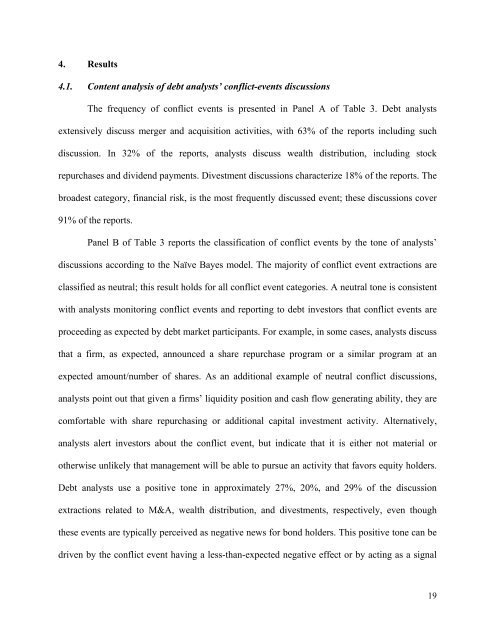Debt Analysts' Views of Debt-Equity Conflicts of Interest
Debt Analysts' Views of Debt-Equity Conflicts of Interest
Debt Analysts' Views of Debt-Equity Conflicts of Interest
You also want an ePaper? Increase the reach of your titles
YUMPU automatically turns print PDFs into web optimized ePapers that Google loves.
4. Results<br />
4.1. Content analysis <strong>of</strong> debt analysts’ conflict-events discussions<br />
The frequency <strong>of</strong> conflict events is presented in Panel A <strong>of</strong> Table 3. <strong>Debt</strong> analysts<br />
extensively discuss merger and acquisition activities, with 63% <strong>of</strong> the reports including such<br />
discussion. In 32% <strong>of</strong> the reports, analysts discuss wealth distribution, including stock<br />
repurchases and dividend payments. Divestment discussions characterize 18% <strong>of</strong> the reports. The<br />
broadest category, financial risk, is the most frequently discussed event; these discussions cover<br />
91% <strong>of</strong> the reports.<br />
Panel B <strong>of</strong> Table 3 reports the classification <strong>of</strong> conflict events by the tone <strong>of</strong> analysts’<br />
discussions according to the Naïve Bayes model. The majority <strong>of</strong> conflict event extractions are<br />
classified as neutral; this result holds for all conflict event categories. A neutral tone is consistent<br />
with analysts monitoring conflict events and reporting to debt investors that conflict events are<br />
proceeding as expected by debt market participants. For example, in some cases, analysts discuss<br />
that a firm, as expected, announced a share repurchase program or a similar program at an<br />
expected amount/number <strong>of</strong> shares. As an additional example <strong>of</strong> neutral conflict discussions,<br />
analysts point out that given a firms’ liquidity position and cash flow generating ability, they are<br />
comfortable with share repurchasing or additional capital investment activity. Alternatively,<br />
analysts alert investors about the conflict event, but indicate that it is either not material or<br />
otherwise unlikely that management will be able to pursue an activity that favors equity holders.<br />
<strong>Debt</strong> analysts use a positive tone in approximately 27%, 20%, and 29% <strong>of</strong> the discussion<br />
extractions related to M&A, wealth distribution, and divestments, respectively, even though<br />
these events are typically perceived as negative news for bond holders. This positive tone can be<br />
driven by the conflict event having a less-than-expected negative effect or by acting as a signal<br />
19
















